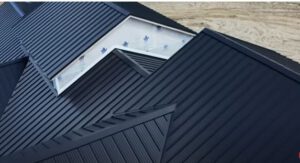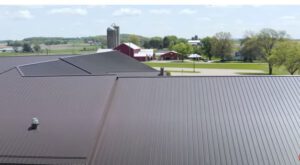The Rising Popularity of Metal Roofing in Australia
 When it comes to building and renovating homes, choosing the right roofing material is a critical decision. In Australia, metal roofing has been gaining popularity over the past few years due to its durability, energy efficiency, and aesthetic appeal. This article will delve into the reasons behind the increasing demand for metal roofing in Australia, the different types of metal roofing available, their benefits and drawbacks, and the factors to consider before installing one.
When it comes to building and renovating homes, choosing the right roofing material is a critical decision. In Australia, metal roofing has been gaining popularity over the past few years due to its durability, energy efficiency, and aesthetic appeal. This article will delve into the reasons behind the increasing demand for metal roofing in Australia, the different types of metal roofing available, their benefits and drawbacks, and the factors to consider before installing one.
Why Metal Roofing is Becoming the Go-To Choice for Australians
Durability
One of the most significant advantages of metal roofing is its durability. Metal roofs can withstand harsh climatic conditions such as heavy rain, hailstorms, bushfires, and wind. Unlike other roofing materials such as tiles and shingles, metal roofs do not easily crack, split, or warp. They are also less susceptible to rust and corrosion, which means they can last for up to 50 years, with little maintenance.
Energy Efficiency
In Australia, energy costs have been on the rise, making homeowners seek ways to reduce their energy consumption. Installing a metal roof can help achieve this goal. Metal roofing has excellent insulation properties, which means it can reflect the sun’s rays, reducing heat absorption by up to 50%. This feature can significantly lower cooling costs during the hot summer months, making it an economical choice in the long run.
Aesthetic Appeal
Gone are the days when metal roofing was only associated with commercial and industrial buildings. In recent years, metal roofing has evolved to suit a range of architectural styles, giving homeowners more options to choose from. Today, metal roofs come in various colors, finishes, and textures, including matte, glossy, and metallic. They can also mimic other roofing materials such as tiles and shingles, creating a natural look while retaining the benefits of metal roofing.
Environmentally Friendly
Another reason why metal roofing is becoming popular in Australia is its eco-friendliness. Most metal roofs are made from recycled materials, making them an excellent choice for homeowners who want to reduce their carbon footprint. Furthermore, once metal roofs reach the end of their lifespan, they can be recycled again, reducing waste and conserving natural resources.
Different Types of Metal Roofing Available
Colorbond Roofing
Colorbond is a popular brand of metal roofing in Australia. It is made from high-quality steel, which is coated with a layer of zinc and aluminum to prevent corrosion. Colorbond roofing comes in a wide range of colors and finishes, making it easy to match any architectural style. Additionally, it is lightweight, durable, and resistant to chipping, cracking, and peeling.
Zincalume Roofing
Zincalume is another type of metal roofing that has gained popularity in Australia. It is made from a combination of zinc, aluminum, and magnesium alloy, making it highly resistant to rust and corrosion. Zincalume roofing is also lightweight and durable, making it ideal for areas with high wind gusts. Moreover, it is easily recyclable, making it an eco-friendly option for homeowners.
Aluminium Roofing
Aluminium roofing is a lightweight and durable option that is gaining popularity among Australians. It is highly resistant to corrosion, making it suitable for coastal areas with high salt exposure. Aluminium roofing is also energy efficient, reflecting the sun’s rays and reducing heat absorption. However, it is not as widely available as colorbond and zincalume roofing.
Steel Roofing
Steel roofing is a classic option that has been used for decades in Australia. It is strong, durable, and resistant to fire and pests. Steel roofing comes in various shapes and sizes, making it easy to customize to any architectural style. However, it is susceptible to rust and corrosion unless protected by a quality coating.
Pros and Cons of Metal Roofing
Pros
- Durability: Metal roofing can last for up to 50 years, making it a long-term investment.
- Energy Efficiency: Metal roofing has excellent insulation properties, reducing cooling costs during summer.
- Aesthetic Appeal: Metal roofing comes in various colors and finishes, making it easy to match any architectural style.
- Environmentally Friendly: Most metal roofs are made from recycled materials, and they can be recycled again once they reach the end of their lifespan.
Cons
- Cost: Metal roofing is generally more expensive than other roofing materials such as tiles and shingles.
- Noise: Rain and hail can produce loud noises on metal roofing, which may be bothersome to some homeowners.
- Installation: Metal roofing requires specialized installation, which can add to the overall cost.
- Maintenance: Metal roofing requires periodic maintenance to ensure it remains in good condition.
Factors to Consider Before Installing a Metal Roof
Climate
 The climate in your area is a crucial factor to consider when installing a metal roof. Some metals are more susceptible to corrosion in areas with high salt exposure or acid rain. Moreover, some metals may not withstand extreme temperatures, whether hot or cold.
The climate in your area is a crucial factor to consider when installing a metal roof. Some metals are more susceptible to corrosion in areas with high salt exposure or acid rain. Moreover, some metals may not withstand extreme temperatures, whether hot or cold.
Cost
Metal roofing is a more expensive option when compared to traditional asphalt shingle roofing materials, but the cost of installation may be offset by the long-term durability and energy savings associated with metal roofs. It’s important to consider both short and long-term costs when installing a metal roof.
Design/Appearance
Metal roofs come in many different colors, shapes and styles, so you have plenty of options to choose from when selecting the right look for your home. However, it’s important to consider the roof’s appearance on both older and newer homes. If you are replacing a roof on an older home, make sure the design of your new metal roof complements the existing architectural style.